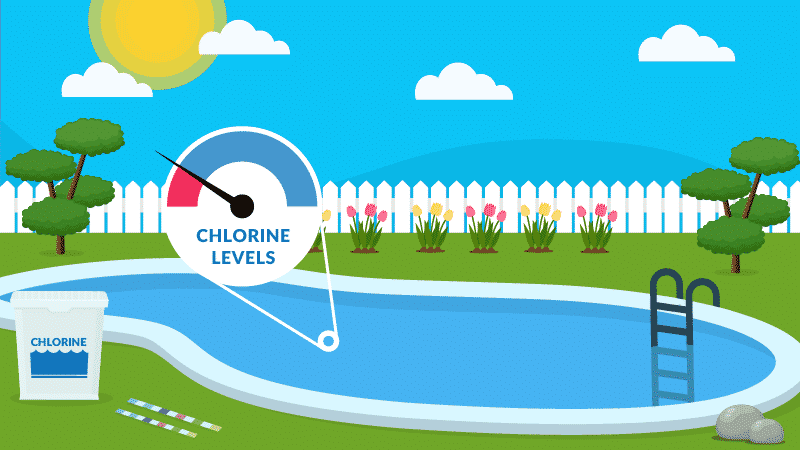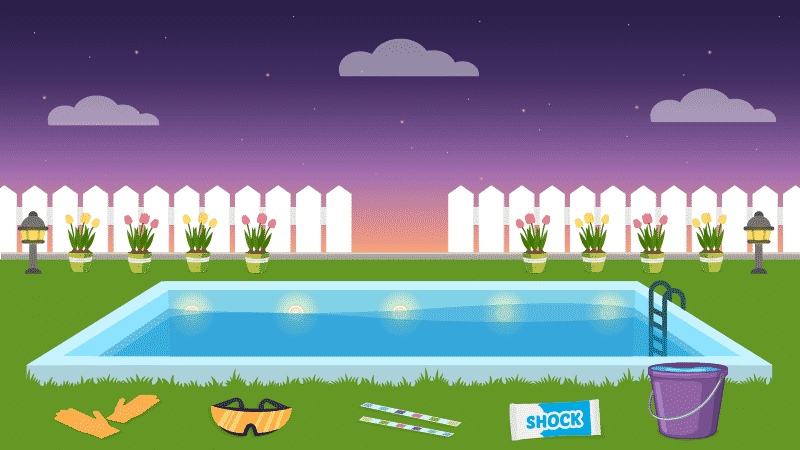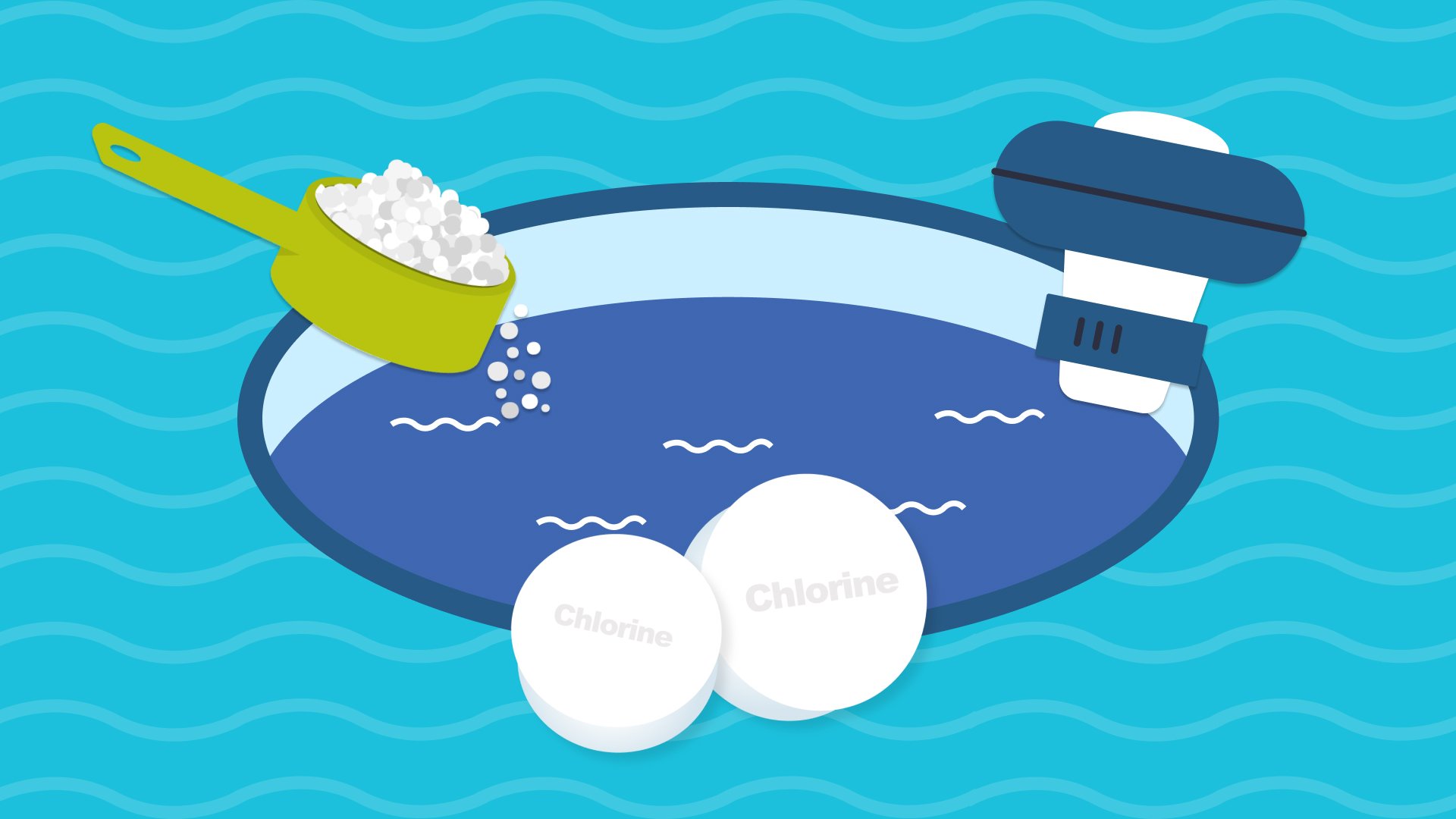CYA Levels High? Here’s How To Lower Cyanuric Acid in a Pool
Cyanuric acid (CYA), sometimes referred to as a pool conditioner or pool stabilizer, is crucial for maintaining your water’s chemical balance. But while CYA helps protect your chlorine from the sun’s ultraviolet rays, too much cyanuric acid isn’t good for your water chemistry.
Ideally, your cyanuric acid levels should be between 30 and 50 parts per million (PPM) and a bit higher if you have a saltwater pool. But if your levels are a lot higher, it may be time to lower the cyanuric acid in your pool.
In order to bring down your cyanuric acid levels, you’ll need to dilute your water by partially draining and refilling your pool. While there are other options, like cyanuric acid reducers, they’re not as effective. But before you tackle a high CYA problem, you’ll need to stop making it worse. Here’s everything you need to know about what causes high cyanuric acid levels and what you can do to lower them.
Check out the video tutorial below on how to lower your CYA levels or keep reading for a complete guide.
Stop wasting time and money with confusing water chemistry and maintenance. Our effortless system guarantees to keep your pool balanced, sanitized, and crystal clear all year. Works for all pools including saltwater.
What Causes High Cyanuric Acid?
The most common contributor to high CYA levels is stabilized chlorine. Stabilized chlorine comes with small amounts of CYA, which helps protect your sanitizer from being destroyed by the sun.
Most chlorine tablets or chlorine granules are made with stabilized dichlor and trichlor. So if you add one pound of trichlor chlorine to a 10,000-gallon pool, it can raise the CYA level by 6 ppm. On the other hand, calcium hypochlorite (cal-hypo) chlorine, lithium hypochlorite chlorine, and liquid bleach are unstabilized. These won’t increase your CYA levels.
As you add stabilized chlorine to your water, the levels of cyanuric acid can build up over time, even as the chlorine levels fluctuate up and down. That’s because as water evaporates from the swimming pool, cyanuric acid remains in the water. So while you’re trying to bring down your cyanuric acid levels, stop adding stabilized chlorine.
Not everyone needs to worry about high CYA levels, though. If you’re a pool owner who drains and refills your pool each year or you have an indoor pool, you likely won’t need to worry about a build-up of cyanuric acid. But if you have an outdoor pool you keep open all year and you don’t get a lot of rain, you’ll need to monitor your CYA levels.
What Happens if Cyanuric Acid Levels are Too High?
When your cyanuric acid levels are too high, it can affect your chlorine’s ability to sanitize, damage your pool and skew your water chemistry readings.
Renders Chlorine Less Effective
Too much cyanuric acid can prevent chlorine from effectively doing its job. When CYA increases, the amount of available chlorine that can sanitize the water decreases. And your free chlorine levels should be 7.5 percent of your cyanuric acid levels. So if your pool has CYA levels at 40 ppm, you’ll need to keep your free chlorine levels at 3 ppm to effectively sanitize your water. When left out of balance too long, you’ll start to see cloudy water, and may even see algae growth.
Distorts Total Alkalinity Readings
Cyanuric acid adds to your carbonate alkalinity, and that contributes to total alkalinity. So high CYA levels will return false total alkalinity readings.
Damage to Plaster Finish on Pool Walls
Typically, a high CYA concentration will mean low pH levels, since ineffective chlorine can disrupt the pH balance. This low pH will eat away at the plaster finish on your pool’s walls.
Unsanitary Water
You’ll have less chlorine available to sanitize your water when there’s too much cyanuric acid. And that means you run the risk of bacteria, algae, and contaminants building up.
How to Lower Cyanuric Acid in a Pool
Reducing cyanuric acid levels in your swimming pool isn’t an easy fix. But most importantly, stop adding more stabilized chlorine to your pool as soon as possible. This contains cyanuric acid and continuing to add it to your water will make the problem worse.
1. Dilute Pool Water by Partially Draining and Refilling
Diluting your water is the easiest and most effective way to lower cyanuric acid in your pool. This means draining some of your pool water and replacing it with fresh water. Rainwater can also help dilute your water and CYA levels, but the acidic nature of rain can upset your pool water’s balance.
Before diluting your water, test your water with test strips or a liquid test kit to determine your current CYA level. If your CYA levels are extremely high, your reading might be “off the chart” and you’ll need to take a water sample to your local pool store.
Begin partially draining your pool using a submersible pump, a hose siphon, or the waste setting on your filtration system. If you’re using your filter, set your valve to “waste” or drain. Keep in mind that you may only need to remove a few inches of water. And as you drain your pool, just make sure your water levels never reach below the skimmer. This will protect your pump from running dry.
Once you’ve drained out some of the water, refill your swimming pool with fresh water and retest your pool chemistry. Continue draining and refilling your water until you reduce cyanuric acid levels to the normal range between 30 and 50 ppm.
2. Try a Chemical Cyanuric Acid Reducer
Even though you can buy cyanuric acid reducers, they tend to be very expensive and don’t work for every pool owner. Remember, the most effective way to lower CYA is by draining and refilling with fresh water. But if you find that your CYA level is incredibly high and you can’t dilute your water, trying a CYA reducer may help.
Keep in mind that cyanuric acid reducers will not work if you’ve added clarifiers, algaecides, or phosphate treatments to the pool in the past week. You’ll also need your pool water to be at least 65°F. And your other pool chemicals, like pH and totally alkalinity, should be in range before using.
3. Use a Reverse Osmosis Filter
If you can’t dilute your water and you have chronically high cyanuric acid levels, you may want to consider purchasing a reverse osmosis filter. Pool water passes through an incredibly fine semi-permeable membrane. Then the water moves through a tank and gets filtered by activated charcoal before going back into the pool.
However, reverse osmosis wastes a lot of water and you can expect to spend a few thousand dollars for the filter and installation. It also creates water waste. With this filter, you’ll create 2 gallons of wastewater for every 1 gallon that passes through your filter.
But many pool owners find reverse osmosis filters helpful because not only will they reduce CYA, but they will also lower calcium hardness and total dissolved solids. And reverse osmosis systems are recommended in places where water shortages and restrictions are in place. So even though it wastes some water, it will save more water overall compared to an extensive pool drain and refill.
Frequently Asked Questions About Lowering Cyanuric Acid
Need more help lowering the CYA levels in your pool? Here are some common questions and answers.
How do I lower the cyanuric acid in my pool without draining it?
You don’t need to completely drain your pool to lower your cyanuric acid levels. But a partial drain and refill is the most effective way to bring down CYA. Start by partially draining the water by a few inches and adding fresh water to your pool afterward.
What causes cyanuric acid to be high in a pool?
The most common cause of too much cyanuric acid is from adding too much stabilized chlorine. In many chlorine products, CYA is included as a chlorine stabilizer. This helps slow down chlorine loss as a result of the sun’s UV rays. But as the chlorine breaks down, the CYA stays behind in the water, gradually increasing your cyanuric acid levels over time.
Is it safe to swim in a pool with high cyanuric acid?
While technically it is safe to swim in a pool with high levels of CYA, it can affect your other chemicals. Too much cyanuric acid can reduce your chlorine effectiveness, making the water unsanitary.
What if my cyanuric acid is too high?
High cyanuric acid levels can damage your pool liner, contribute to false water chemistry readings, and reduce your chlorine’s ability to sanitize. And if your water isn’t properly sanitized, you may experience cloudy water and algae issues.
4 Ways We Can Help With Your Pool
- Pool Care Cheat Sheets (Free): Easy-to-use downloadable guides to help you keep track of taking care of your pool this year.
- The Pool Care Handbook: An illustrated guide to DIY pool care, including water chemistry, maintenance, troubleshooting, and more.
- The Pool Care Video Course: You’ll get 30+ step-by-step videos and a downloadable guide with everything you need to know about pool maintenance.
- The Pool Care App: Enter your water test results. Get a custom treatment plan. Know exactly what chemicals to add to keep your pool clear.









